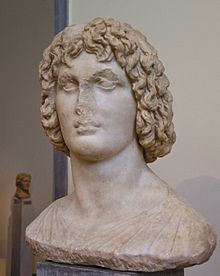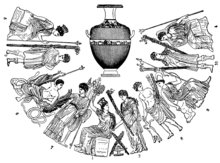Eubuleus
Eubuleus ( Greek Εὐβουλεύς "the good adviser") is a figure of Greek mythology closely linked to the mysteries of Eleusis , the outlines of which remain unclear. His name appears in different spellings (Eubuleus, Euboulos , Eubouleos and Eubolos ) both in ancient texts and on the so-called Orphic gold leaves , although it is not clear whether the different names denote different figures or not. This is already addressed in the Orphic Hymn :
- I call you ... owl of many names who carries the leafy staff
Elsewhere in the Orphic hymns, however, Eubulus appears as an epithet of Hades and in Diodorus as an epithet of Zeus . Finally, Cicero names Eubuleus, alongside Tritopatreus and Dionysus, as one of the first Dioscuri , children of the eldest Jupiter and Proserpine .
Eubulus is also said to be a son of Demeter and father of Karme , the mother of Britomartis . According to Pausanias, however, he is a son of Karmenor, the father of the Karme just mentioned. Elsewhere at Pausanias, Trochilus, a priest who fled Argos to Eleusis, becomes the father of Eubuleus and Triptolemus . And immediately afterwards Pausanias gives another Orphic tradition according to which Eubuleus and Triptolemus were the sons of Dysaules .
So far, none of these epic readings and genealogies have any direct reference to the cult events in Eleusis . A possible relationship appears in a myth in which the origin of the cult custom of the Thesmophoria of throwing pigs into a pit and later offering the remains is traced back to a swineherd named Eubuleus, whose herd was partially torn down when Persephone was kidnapped when Hades opened the mouth of the underworld for his chariot.
In iconography Eubuleus appears as a young man with curly hair carrying a torch, for example on the so-called Regina Vasorum , a hydria of the 4th century with representations of Eleusinian deities. The marble sculpture of the 4th century attributed to Praxiteles and known as the "head of Eubuleus" was found in the Plutonion of Eleusis, but today it is assumed that it represents Alexander the Great .
literature
- Kevin Clinton: Eubuleus. In: The New Pauly (DNP). Volume 4, Metzler, Stuttgart 1998, ISBN 3-476-01474-6 , column 210 f.
- Kevin Clinton: Myth and Cult: the Iconography of the Eleusinian Mysteries. 1992, pp. 51-63, 71-73, 78-79
- Heinrich Wilhelm Stoll : Eubuleus . In: Wilhelm Heinrich Roscher (Hrsg.): Detailed lexicon of Greek and Roman mythology . Volume 1,1, Leipzig 1886, column 1397 ( digitized version ).
- Friedrich A. Voigt: Eubulus . In: Wilhelm Heinrich Roscher (Hrsg.): Detailed lexicon of Greek and Roman mythology . Volume 1,1, Leipzig 1886, column 1397 ( digitized version ).
Web links
- Eubuleus in the Theoi Project (English)
Individual evidence
- ↑ Orphic Hymn 42 to Mise
- ↑ Orphic Hymn December 17, June 29, March 55
- ↑ Diodorus 5.72.2
- ↑ Cicero de natura deorum 3.53
- ↑ Diodorus 5.76.3
- ↑ Pausania's description of Greece 2.20.3
- ↑ Pausania's description of Greece 1.14.2-3
- ↑ Clemens of Alexandria Protrepticus 17.1; Scholion zu Lukian von Samosata Whore Conversations 2.1, see article by Erwin Rohde in Rheinisches Museum 25, p. 528ff

